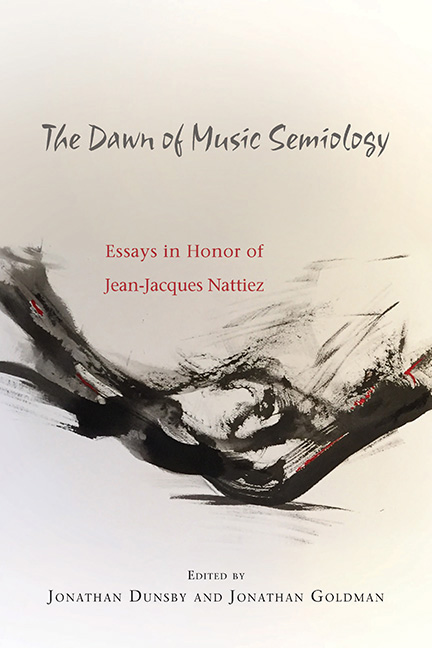Book contents
- Frontmatter
- Contents
- Foreword: About Jean-Jacques Nattiez
- Acknowledgments
- Introduction
- Part One Metaconsiderations
- Part Two Poietic Channels
- Part Three Esthesic Excursions
- 7 Musical Borrowings in the Works of Bruno Maderna
- 8 Of Doubles, Groups, and Rhymes: A Seriation of Works for Spatialized Orchestral Groups (1958–60)
- 9 The Psychological Organization of Music Listening: From Spontaneous to Learned Perceptive Processes
- Selected Bibliography of Works by Jean-Jacques Nattiez
- List of Contributors
- Index
- Tabula Gratulatoria
9 - The Psychological Organization of Music Listening: From Spontaneous to Learned Perceptive Processes
from Part Three - Esthesic Excursions
Published online by Cambridge University Press: 26 April 2018
- Frontmatter
- Contents
- Foreword: About Jean-Jacques Nattiez
- Acknowledgments
- Introduction
- Part One Metaconsiderations
- Part Two Poietic Channels
- Part Three Esthesic Excursions
- 7 Musical Borrowings in the Works of Bruno Maderna
- 8 Of Doubles, Groups, and Rhymes: A Seriation of Works for Spatialized Orchestral Groups (1958–60)
- 9 The Psychological Organization of Music Listening: From Spontaneous to Learned Perceptive Processes
- Selected Bibliography of Works by Jean-Jacques Nattiez
- List of Contributors
- Index
- Tabula Gratulatoria
Summary
Introduction
Context
What happens in the minds of those listening to a musical work in a concert hall or other location? This frequently asked question continues to be surrounded by more mysteries than answers. While a variety of mental activities are in operation during listening, these activities resist description if they fail to leave concrete traces. Some listeners display observable signs of listening, but these do not go beyond foot tapping or head nodding induced by the rhythmic pulsation of the music. Nor do they reveal anything about the underlying processes involved in the perception of a work or the way mental representations are constructed.
To delve into a field that is so clearly hermetic requires a few precautions and requires us to specify what kind of musical listening will be under discussion here. In certain cases, one can, in effect, define listening as a creative act inasmuch as an individual can inject elements at will that emerge from preferences or from the imagination, such as visions of colored shapes, pastoral scenes, and so on. This would amount to a re-composition in the sense that a musical work is a pretext for an escape into external effects. In this respect, no two listeners can be said to take the same approach, since what the listener brings to the act of listening is fundamentally personal and bound up with states of mind and moods in the moment. Another type of listening is associated with the “consumption” of music as background sound, which drowns out silence and becomes a backdrop for other daily occupations.
Though these situations could well be interesting from a psychological point of view, this chapter will focus—in a ramified theoretical exegesis, followed by examples of selective application—rather on a type of listening that is concerned with the work itself, a listening that “is not reducible to the reception of its acoustic signal,” but tends toward its “codification and unconscious reinterpretation in the form of cognitive signs.”
- Type
- Chapter
- Information
- The Dawn of Music SemiologyEssays in Honor of Jean-Jacques Nattiez, pp. 177 - 200Publisher: Boydell & BrewerPrint publication year: 2017



